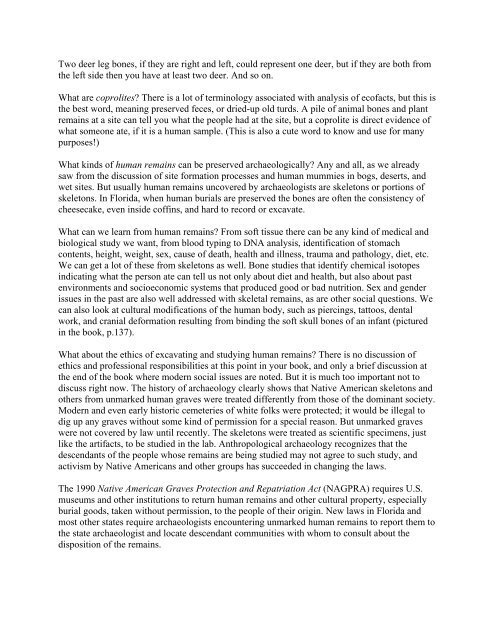INTRODUCTION TO ARCHAEOLOGY Nancy White - Touro Institute
INTRODUCTION TO ARCHAEOLOGY Nancy White - Touro Institute
INTRODUCTION TO ARCHAEOLOGY Nancy White - Touro Institute
Create successful ePaper yourself
Turn your PDF publications into a flip-book with our unique Google optimized e-Paper software.
Two deer leg bones, if they are right and left, could represent one deer, but if they are both from<br />
the left side then you have at least two deer. And so on.<br />
What are coprolites? There is a lot of terminology associated with analysis of ecofacts, but this is<br />
the best word, meaning preserved feces, or dried-up old turds. A pile of animal bones and plant<br />
remains at a site can tell you what the people had at the site, but a coprolite is direct evidence of<br />
what someone ate, if it is a human sample. (This is also a cute word to know and use for many<br />
purposes!)<br />
What kinds of human remains can be preserved archaeologically? Any and all, as we already<br />
saw from the discussion of site formation processes and human mummies in bogs, deserts, and<br />
wet sites. But usually human remains uncovered by archaeologists are skeletons or portions of<br />
skeletons. In Florida, when human burials are preserved the bones are often the consistency of<br />
cheesecake, even inside coffins, and hard to record or excavate.<br />
What can we learn from human remains? From soft tissue there can be any kind of medical and<br />
biological study we want, from blood typing to DNA analysis, identification of stomach<br />
contents, height, weight, sex, cause of death, health and illness, trauma and pathology, diet, etc.<br />
We can get a lot of these from skeletons as well. Bone studies that identify chemical isotopes<br />
indicating what the person ate can tell us not only about diet and health, but also about past<br />
environments and socioeconomic systems that produced good or bad nutrition. Sex and gender<br />
issues in the past are also well addressed with skeletal remains, as are other social questions. We<br />
can also look at cultural modifications of the human body, such as piercings, tattoos, dental<br />
work, and cranial deformation resulting from binding the soft skull bones of an infant (pictured<br />
in the book, p.137).<br />
What about the ethics of excavating and studying human remains? There is no discussion of<br />
ethics and professional responsibilities at this point in your book, and only a brief discussion at<br />
the end of the book where modern social issues are noted. But it is much too important not to<br />
discuss right now. The history of archaeology clearly shows that Native American skeletons and<br />
others from unmarked human graves were treated differently from those of the dominant society.<br />
Modern and even early historic cemeteries of white folks were protected; it would be illegal to<br />
dig up any graves without some kind of permission for a special reason. But unmarked graves<br />
were not covered by law until recently. The skeletons were treated as scientific specimens, just<br />
like the artifacts, to be studied in the lab. Anthropological archaeology recognizes that the<br />
descendants of the people whose remains are being studied may not agree to such study, and<br />
activism by Native Americans and other groups has succeeded in changing the laws.<br />
The 1990 Native American Graves Protection and Repatriation Act (NAGPRA) requires U.S.<br />
museums and other institutions to return human remains and other cultural property, especially<br />
burial goods, taken without permission, to the people of their origin. New laws in Florida and<br />
most other states require archaeologists encountering unmarked human remains to report them to<br />
the state archaeologist and locate descendant communities with whom to consult about the<br />
disposition of the remains.
















